17.06.2022
Mars rover Perseverance spots shiny silver litter on the Red Planet (photo)
The detritus is not evidence of litterbug Martians.
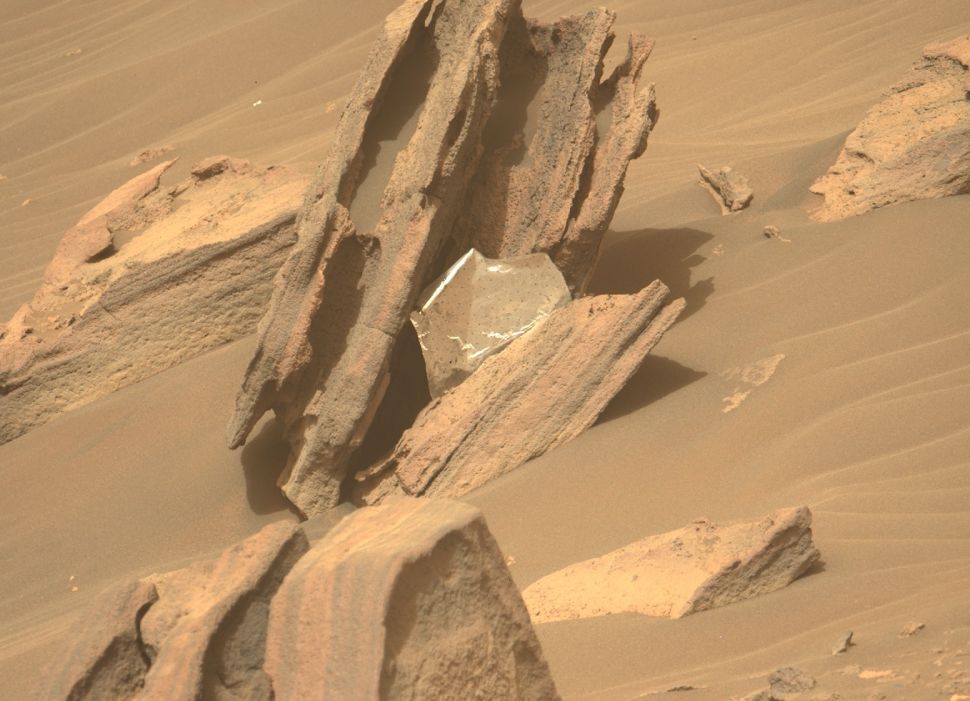
Part of a thermal blanket from the landing gear of NASA's Mars rover Perseverance, as photographed by the robot on June 13, 2022. (Image credit: NASA/JPL-Caltech/ASU)
No, this isn't evidence of advanced (but careless) Martian life.
On Monday (June 13), NASA's Perseverance rover snapped a photo of a shiny silver object wedged between two rocks on the floor of the Red Planet's Jezero Crater, which the car-sized robot has been exploring since its February 2021 touchdown.
This space trash is not native to Mars; Perseverance hauled it from Earth, the rover's handlers said.
"My team has spotted something unexpected: It’s a piece of a thermal blanket that they think may have come from my descent stage, the rocket-powered jet pack that set me down on landing day back in 2021," Perseverance team members wrote via the rover's Twitter account(opens in new tab) today (June 15).
"That shiny bit of foil is part of a thermal blanket — a material used to control temperatures. It’s a surprise finding this here: My descent stage crashed about 2 km [1.2 miles] away. Did this piece land here after that, or was it blown here by the wind?" they added in another tweet(opens in new tab), which featured a closeup of the blanket bit.
This isn't the first time we've gotten a look at some of the gear that helped Perseverance hit the red dirt safely. On April 19, NASA's tiny Ingenuity helicopter flew over the rover's backshell and parachute, snapping amazing photos from a variety of angles.
That aerial imagery is helping engineers assess the performance and condition of the backshell and chute, which could inform the design of future Mars missions, NASA officials have said.
Perseverance Mars rover wind sensor damaged by pebbles, but still operational
Higher-than-expected wind speeds struck elements on the Red Planet rover's weather station.

Mars can be an awfully windy place, it turns out.
The Perseverance rover touched down on the Red Planet in February 2021 carrying, among other instruments, a weather station dubbed MarsEnvironmental Dynamics Analyzer (MEDA). That instrument includes two wind sensors that measure speed and direction, among several other sensors that provide weather metrics such as humidity, radiation and air temperature.
Pebbles carried aloft by strong Red Planet gusts recently damaged one of the wind sensors, but MEDA can still keep track of wind at its landing area in Jezero Crater, albeit with decreased sensitivity, José Antonio Rodriguez Manfredi, principal investigator of MEDA, told Space.com.
"Right now, the sensor is diminished in its capabilities, but it still provides speed and direction magnitudes," Rodriguez Manfredi, a scientist at the Spanish Astrobiology Center in Madrid, wrote in an e-mail. "The whole team is now re-tuning the retrieval procedure to get more accuracy from the undamaged detector readings."
The two approximately ruler-sized wind sensors on Perseverance are encircled by six individual detectors that aim to give accurate readings from any direction, according to materials(opens in new tab) from NASA's Jet Propulsion Laboratory in California, which manages the rover.
Each of the two main wind sensors is attached to a boom that can unfold to move the sensors away from the rover as it drives, because the car-sized Perseverance does affect wind currents by its own movements through the thin Martian atmosphere, JPL officials stated.
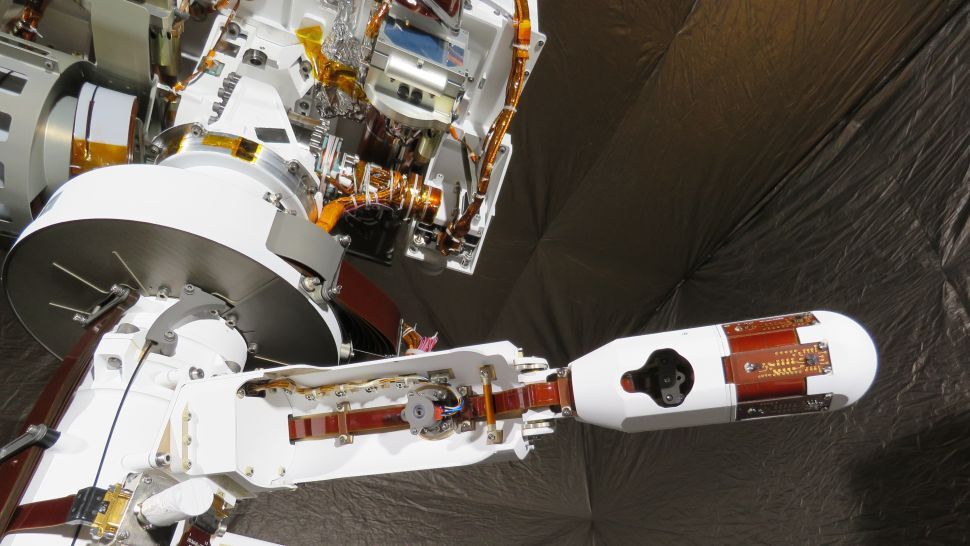
The Perseverance rover deploys one of its wind sensors on the Mars Environmental Dynamics Analyzer (MEDA) during practice activities on Earth in 2019.NASA
Like all instruments on Perseverance, the wind sensor was designed with redundancy and protection in mind, Rodriguez Manfredi noted. "But of course, there is a limit to everything."
And for an instrument like MEDA, the limit is more challenging, since the sensors must be exposed to environmental conditions in order to record wind parameters. But when stronger-than-anticipated winds lifted larger pebbles than expected, the combination resulted in damage to some of the detector elements.
"Neither the predictions nor the experience we had from previous missions foresaw such strong winds, nor so much loose material of that nature," Rodriguez Manfredi said. (He is also principal investigator of another temperature and wind sensor on the NASA InSight lander, on the Red Planet since November 2018 and expected to end its mission this year.)
He added it was was ironic that the sensors were damaged by wind, or "precisely by what we went looking for."
Perseverance landed on Mars on Feb. 18, 2021, and, along with a helicopter called Ingenuity, is exploring an ancient river delta that may have been rich in microbes billions of years ago.
Besides measuring wind, weather and rock composition, the rover is picking up the most promising material to cache for a future sample return-mission aiming to send samples to Earth in the 2030s.
Quelle: Space.com
----
Update: 15.07.2022
.
Ingenuity Postpones Flights Until August
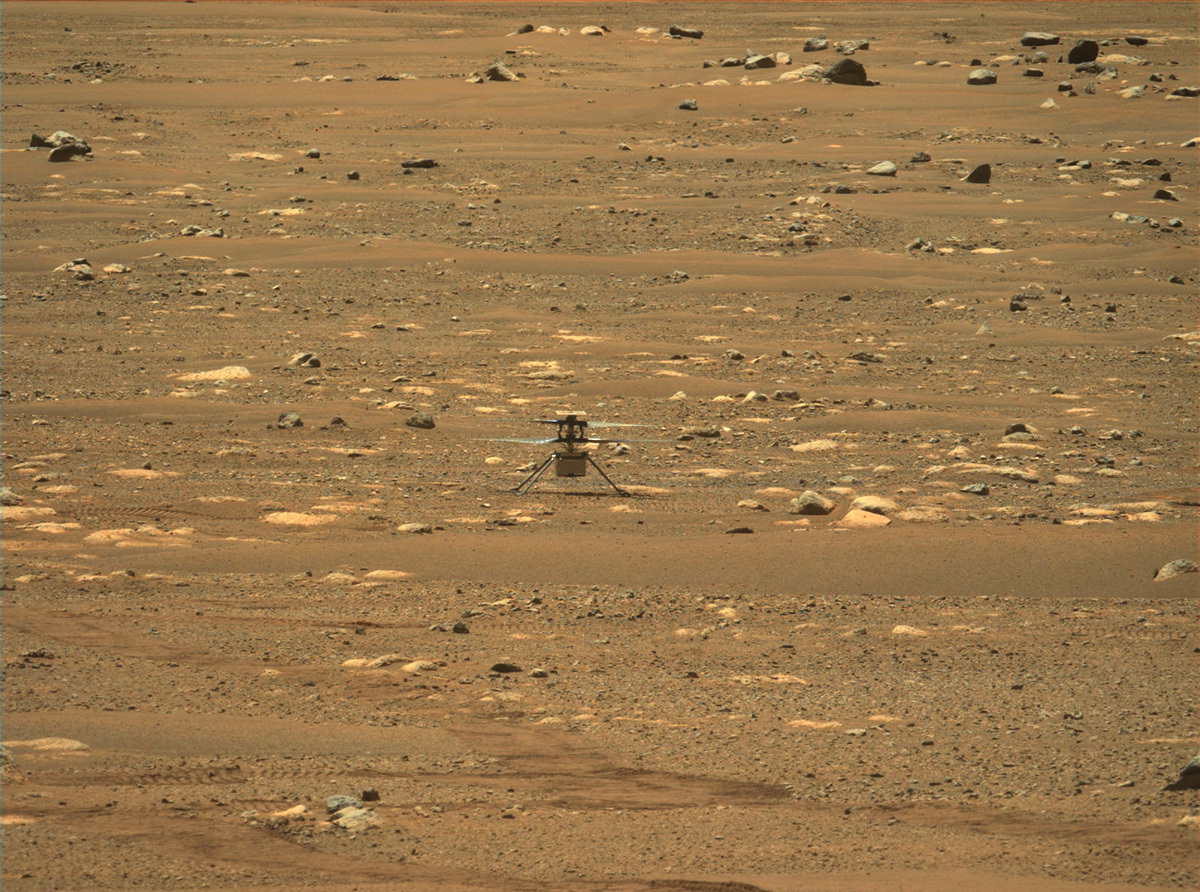
Ingenuity's First Flight Recorded by Mastcam-Z: The first flight of NASA’s Ingenuity Mars Helicopter – and the first powered, controlled flight on another planet – was captured in this image from Mastcam-Z, a pair of zoomable cameras aboard NASA’s Perseverance Mars rover, on April 19, 2021. Credits: NASA/JPL-Caltech/ASU
It’s now dust season and winter on Mars, meaning there’s more dust in the air and less sunlight to help recharge Ingenuity’s batteries. Dust levels are expected to subside later in July, so the team has decided to give the helicopter’s batteries a break for a few weeks and build their daily state of charge back up. Weather permitting, Ingenuity is expected to be back in the air around the start of August.
Quelle: NASA
----
Update: 25.08.2022
.
NASA's Ingenuity helicopter makes 30th Martian flight
It was the first liftoff for Ingenuity in more than two months.
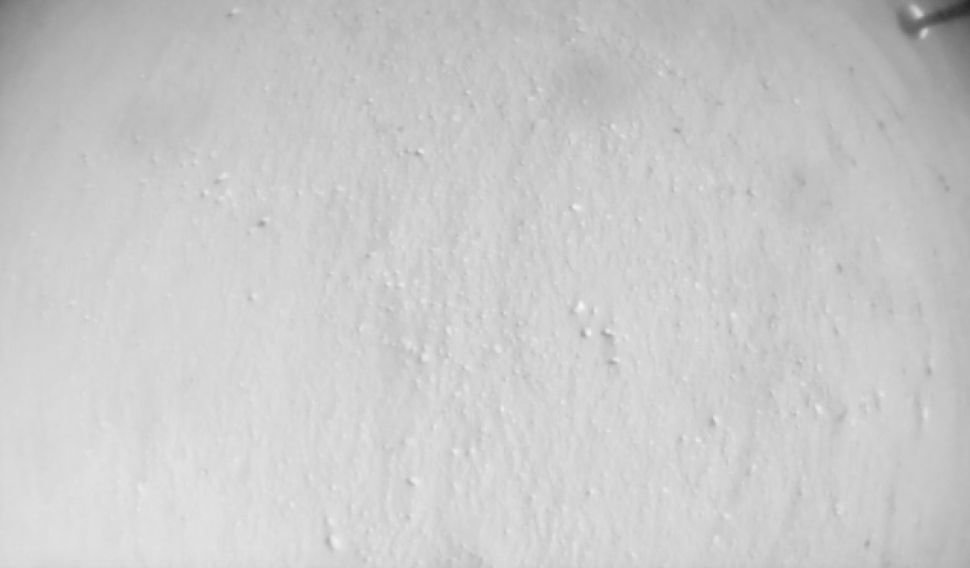
NASA's Ingenuity Mars helicopter captured this image on its 30th flight, on Aug. 20, 2022. (Image credit: NASA/JPL-Caltech)
NASA's Ingenuity helicopter now has 30 Martian flights under its belt.
The 4-pound (1.8 kilograms) Ingenuity took to the skies on Saturday (Aug. 20) for the first time in more than two months, acing a short hop that was its 30th overall Red Planet sortie.
Ingenuity had been grounded since June 11, through no fault of its own. It's winter at the helicopter's locale, the 28-mile-wide (45 kilometers) Jezero Crater, and the solar-powered Ingenuity isn't getting enough sunlight to keep its batteries charged both day and night, mission team members wrote in a recent blog post(opens in new tab).
That issue, which is worsened by the buildup of dust on Ingenuity's solar panel, precludes long and ambitious flights, but short hops are still possible at the moment. And the Ingenuity team decided to take the little rotorcraft out for a brief spin on Saturday to make sure it's still doing OK after experiencing more than 100 freezing-cold Martian winter nights.
The flight was designed to last 33 seconds and cover just 6.5 feet (2 meters) of horizontal distance, according to the blog post. And Ingenuity apparently hit those marks.
"The #MarsHelicopter is back in flight! After a two-month hiatus, the rotorcraft did a short hop over the weekend so the team can check its vitals and knock some dust off the solar panel," NASA's Jet Propulsion Laboratory (JPL) in Southern California, which manages Ingenuity's mission, said via Twitter on Monday(opens in new tab) (Aug. 22).
Ingenuity landed with NASA's Perseverance rover in February 2021 on the floor of Jezero Crater, which hosted a lake and a river delta billions of years ago. Perseverance is searching for signs of ancient Mars life and collecting dozens of samples for future return to Earth.
Ingenuity was originally tasked with a five-flight campaign designed to show that helicopters can explore Mars. The little chopper aced that technology-demonstration more than a year ago and is now serving as a scout for Perseverance.
Perseverance has reached the ancient river delta, and Ingenuity should join the rover there soon, after the weather improves a bit. (The rotorcraft hasn't been able to follow Perseverance closely during its winter quiescent period.)
"We intend to continue our flight path toward the river delta in the coming weeks while the environment (and thus the daily recoverable battery charge) continues to improve," Teddy Tzanetos, Ingenuity team lead at JPL, wrote in the recent update.
"With higher battery states of charge will come longer flights, and eventually Ingenuity will be able to power its internal heaters overnight, which will stop its electronics from freezing in the Martian cold each evening," he added. "Also planned for September is a flight-software upgrade that will enable new navigation capabilities so that Ingenuity can fly better across the challenging river delta terrain in the months ahead."
Quelle: SC
----
Update: 27.08.2022
.
NASA’s Perseverance Makes New Discoveries in Mars’ Jezero Crater
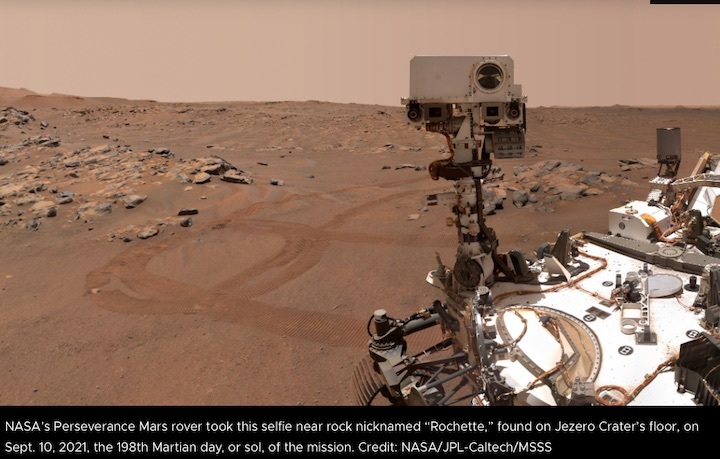
The rover found that Jezero Crater’s floor is made up of volcanic rocks that have interacted with water.
Scientists got a surprise when NASA’s Perseverance Mars rover began examining rocks on the floor of Jezero Crater in spring of 2021: Because the crater held a lake billions of years ago, they had expected to find sedimentary rock, which would have formed when sand and mud settled in a once-watery environment. Instead, they discovered the floor was made of two types of igneous rock – one that formed deep underground from magma, the other from volcanic activity at the surface.
The findings are described in four new papers published Thursday, Aug. 25. In Science, one offers an overview of Perseverance’s exploration of the crater floor before it arrived at Jezero’s ancient river delta in April 2022; a second study in the same journal details distinctive rocks that appear to have formed from a thick body of magma. The other two papers, published in Science Advances, detail the unique ways that Perseverance’s rock-vaporizing laser and ground-penetrating radar established that igneous rocks cover the crater floor.
Rock of Ages
Igneous rocks are excellent timekeepers: Crystals within them record details about the precise moment they formed.
“One great value of the igneous rocks we collected is that they will tell us about when the lake was present in Jezero. We know it was there more recently than the igneous crater floor rocks formed,” said Ken Farley of Caltech, Perseverance’s project scientist and the lead author of the first of the new Science papers. “This will address some major questions: When was Mars’ climate conducive to lakes and rivers on the planet’s surface, and when did it change to the very cold and dry conditions we see today?”

NASA’s Perseverance Mars rover looks out at an expanse of boulders on the floor of Jezero Crater in front of a location nicknamed “Santa Cruz” on Feb. 16, 2022, the 353rd Martian day, or sol, of the mission.
However, because of how it forms, igneous rock isn’t ideal for preserving the potential signs of ancient microscopic life Perseverance is searching for. In contrast, determining the age of sedimentary rock can be challenging, particularly when it contains rock fragments that formed at different times before the rock sediment was deposited. But sedimentary rock often forms in watery environments suitable for life and is better at preserving ancient signs of life.
That’s why the sediment-rich river delta Perseverance has been exploring since April 2022 has been so tantalizing to scientists. The rover has begun drilling and collecting core samples of sedimentary rocks there so that the Mars Sample Return campaign could potentially return them to Earth to be studied by powerful lab equipment too large to bring to Mars.
Mysterious Magma-Formed Rocks
A second paper published in Science solves a longstanding mystery on Mars. Years ago, Mars orbiters spotted a rock formation filled with the mineral olivine. Measuring roughly 27,000 square miles (70,000 square kilometers) – nearly the size of South Carolina – this formation extends from the inside edge of Jezero Crater into the surrounding region.
Scientists have offered various theories why olivine is so plentiful over such a large area of the surface, including meteorite impacts, volcanic eruptions, and sedimentary processes. Another theory is that the olivine formed deep underground from slowly cooling magma – molten rock – before being exposed over time by erosion.
Yang Liu of NASA’s Jet Propulsion Laboratory in Southern California and her co-authors have determined that last explanation is the most likely. Perseverance abraded a rock to reveal its composition; studying the exposed patch, the scientists homed in on the olivine’s large grain size, along with the rock’s chemistry and texture.
Using Perseverance’s Planetary Instrument for X-ray Lithochemistry, or PIXL, they determined the olivine grains in the area measure 1 to 3 millimeters – much larger than would be expected for olivine that formed in rapidly cooling lava at the planet’s surface.
“This large crystal size and its uniform composition in a specific rock texture require a very slow-cooling environment,” Liu said. “So, most likely, this magma in Jezero wasn’t erupting on the surface.”
Unique Science Tools
The two Science Advances papers detail the findings of science instruments that helped establish that igneous rocks cover the crater floor. The instruments include Perseverance’s SuperCamlaser and a ground-penetrating radar called RIMFAX (Radar Imager for Mars’ Subsurface Experiment).
SuperCam is equipped with rock-vaporizing laser that can zap a target as small as a pencil tip from up to 20 feet (7 meters) away. It studies the resulting vapor using a visible-light spectrometer to determine a rock’s chemical composition. SuperCam zapped 1,450 points during Perseverance’s first 10 months on Mars, helping scientists arrive at their conclusion about igneous rocks on the crater floor.
In addition, SuperCam used near-infrared light – it’s the first instrument on Mars with that capability – to find that water altered minerals in the crater floor rocks. However, the alterations weren’t pervasive throughout the crater floor, according to the combination of laser and infrared observations.
“SuperCam’s data suggests that either these rock layers were isolated from Jezero’s lake water or that the lake existed for a limited duration,” said Roger Wiens, SuperCam’s principal investigator at Purdue University and Los Alamos National Laboratory.
RIMFAX marks another first: Mars orbiters carry ground-penetrating radars, but no spacecraft on the surface of Mars have before Perseverance. Being on the surface, RIMFAX can provide unparalleled detail, and surveyed the crater floor as deep as 50 feet (15 meters).
Its high-resolution “radargrams” show rock layers unexpectedly inclined up to 15 degrees underground. Understanding how these rock layers are ordered can help scientists build a timeline of Jezero Crater’s formation.
“As the first such instrument to operate on the surface of Mars, RIMFAX has demonstrated the potential value of a ground-penetrating radar as a tool for subsurface exploration,” said Svein-Erik Hamran, RIMFAX’s principal investigator at the University of Oslo in Norway.
The science team is excited by what they’ve found so far, but they’re even more excited about the science that lies ahead.
More About the Mission
A key objective for Perseverance’s mission on Mars is astrobiology, including the search for signs of ancient microbial life. The rover will characterize the planet’s geology and past climate, pave the way for human exploration of the Red Planet, and be the first mission to collect and cache Martian rock and regolith (broken rock and dust).
Subsequent NASA missions, in cooperation with ESA (European Space Agency), would send spacecraft to Mars to collect these sealed samples from the surface and return them to Earth for in-depth analysis.
The Mars 2020 Perseverance mission is part of NASA’s Moon to Mars exploration approach, which includes Artemis missions to the Moon that will help prepare for human exploration of the Red Planet.
JPL, which is managed for NASA by Caltech in Pasadena, California, built and manages operations of the Perseverance rover.
Quelle: NASA
----
Update: 14.09.2022
.
NASA to Host Briefing on Perseverance Mars Rover Mission Operations

Editor's Note: This advisory was updated Tuesday, Sept. 13, 2022, to note that Rick Welch, Perseverance deputy project manager is now participating in the briefing in place of Art Thompson, Perseverance project manager.
NASA will host a briefing at 11:30 a.m. EDT (8:30 a.m. PDT) on Thursday, Sept. 15, at the agency’s Jet Propulsion Laboratory in Southern California to provide highlights from the first year and a half of the Perseverance rover’s exploration of Mars.
The rover landed in Mars’ Jezero Crater in February 2021 and is collecting samples of rock and other materials from the Martian surface. NASA’s Perseverance is investigating the sediment-rich ancient river delta in the Red Planet’s Jezero Crater.
The briefing will livestream on NASA Television, Twitter, Facebook, and YouTube, as well as the agency’s app. Watch on the agency’s website at:
Participants will include:
- Lori Glaze, director of NASA’s Planetary Science Division, NASA Headquarters
- Laurie Leshin, JPL director
- Rick Welch, Perseverance deputy project manager, JPL
- Ken Farley, Perseverance project scientist, Caltech
- Sunanda Sharma, Scanning Habitable Environments with Raman and Luminescence for Organics and Chemicals scientist, JPL
- David Shuster, Perseverance returned sample scientist, University of California, Berkeley
Members of the U.S. media interested in covering the event in person at JPL must arrange access in advance by emailing Rexana Vizza at: rexana.v.vizza@jpl.nasa.gov no later than 7 p.m. EDT (4 p.m. PDT) on Tuesday, Sept. 13. Foreign media outlets must RSVP by 7 p.m. EDT (4 p.m. PDT) on Monday, Sept. 12. Valid media credentials are required for on-site access. The agency’s media accreditation policy is available online.
To ask questions by phone, members of the media need to RSVP no later than two hours before the start of the event on Thursday, Sept. 15. Questions can be asked on social media during the briefing using #AskNASA.
Perseverance marks the first step in the Mars Sample Return campaign, which would return scientifically-promising samples to Earth for further study using the most sophisticated instruments around the world. These samples collected by Perseverance during its exploration of an ancient river delta are thought to be the best opportunity to reveal the early evolution of Mars, including the potential for life.
Quelle: NASA
----
Update: 18.09.2022
.
PERSEVERANCE FINDS ANCIENT HABITABLE CONDITIONS (BUT NOT YET LIFE) ON MARS
The mission team has reported results from Perseverance’s study of the rocks deposited by the river flowing into Jezero Crater.

NASA has announced a status update on the Perseverance rover trundling through Jezero Crater on Mars, highlighting news from the mission's second science campaign.
Scientists already know that Jezero was filled with a lake some 3.5 billion years ago, fed in part by a river that broke through the walls of the crater rim. Now, scientists are revealing the first results from investigations of the delta deposits that river left behind.
LAVA FIRST, WATER SECOND
In the first science campaign, during which Perseverance explored the crater floor, the rover found not squished sedimentary layers but igneous rocks, evidence that volcanic activity once deposited material inside Jezero.

NASA / JPL-Caltech / MSSS
“Our Planetary Instrument for X-ray Lithochemistry (PIXL) instrument got a good look at the abraded patch of a rock from the area nicknamed ‘South Séítah,’ and it all became clear: The crystals within the rock provided the smoking gun,” explains Perseverance project scientist Ken Farley (Caltech).
What PIXL saw were large olivine crystals encased in pyroxene crystals, formed long ago in slowly cooling magma. That magma may have flowed thick on the surface or lain underground in a chamber. In any case, after it crystallized, other chemical evidence shows these minerals later interacted with water not just once but multiple times.
Perseverance collected several samples of these igneous rocks. When a future mission returns these samples to Earth, scientists in Earth-based labs will be able to test them to determine when water filled Jezero Crater.
NASA / JPL-Caltech / ASU / MSSS
But all the while the rover drove on the crater floor, many scientists' eyes were on the delta in the distance. There, a river had once breached the crater rim and met the lake that filled Jezero, depositing sediments. There was scientists' best chance to detect signs of life, if they exist.
To drive to the ancient delta, Perseverance first had to dash around vast sand dunes, using autonomous navigation to help complete a drive of 5 kilometers (3 miles) in just over 31 days, a record for the rover.
After an April arrival, the team spent five months examining sedimentary rocks in what they call the Delta Front Region. The team took two samples each from two ridges, Skinner and Wildcat. The two ridges are very different, says David Shuster (University of California, Berkeley). Skinner Ridge has a mixture of sedimentary rocks that have traveled to the delta from a long ways away, while Wildcat Ridge hosts sedimentary, sulfate- and salt-bearing mudstone and clays. These rocks would have formed in salty brines as the lake water evaporated.
While igneous rocks can't preserve organic matter, sedimentary rocks are different: They easily preserve biosignatures, so if biological activity was present when the sedimentary rocks formed, the rock core samples will likely reveal it, Shuster explains. "If these conditions existed on Earth over the last 3.5 billion years, it's safe to say biology would have left its mark in these rocks for us to observe."
(It's important to note, though, that the surface of Mars today is completely inhospitable to life — any signs of life found on the surface, if found at all, would be ancient, having lived billions of years ago. Fortunately for us, the Martian surface doesn't change much, and might preserve even such ancient signatures.
Although the search for definitive signs of life will have to wait for the sample return, Perseverance can look for some non-definitive signs of life now, using its SHERLOC instrument. SHERLOC's Raman spectrometer has revealed the presence of organic matter, likely aromatic compounds, tied to minerals in the rocks, says SHERLOC scientist Sunanda Sharma (JPL).
Organic molecules contain carbon and typically hydrogen and oxygen, too, and are commonly produced by life processes. But such so-called "organic" molecules are also produced via purely chemical processes that have nothing to do with life, cautions Sharma. Mapping out the distribution of organic material is key to determining how it was produced — and that's something we don't know just yet.
The new readings from Perseverance are also helping scientists sort out the geologic history in the crater, which is key to putting any potential biosignatures in context. While they're still sorting out an exact timeline, it seems clear that the magmatic activity came first: The igneous rocks on the crater floor "are clearly beneath the delta, emplaced before delta was emplaced, before the lake was present," says Farley.
But exactly when each of those things happened, and how many millions of years elapsed in between, and how many times the crater filled with water, and when the river dumped the delta deposits — all that is up in the air until scientists can run tests on samples in earthbound labs.
SAMPLES AND SAMPLE RETURN

ESA
Perseverance has now collected 13 samples to date. You can view the Mars rock sample data on NASA's website. For 12 of the samples, the rover drilled into a rock to remove a core; in one additional case, the rock core crumbled and fell out of the collection tube, but the tube still contains Martian atmosphere.
That's impressive progress over the 1½ years since Perseverance landed on Mars, considering the rover carries 38 tubes available for samples. (Another five tubes are reserved as "witness" tubes. They carry materials that, when exposed to Martian air, may react in different ways.)
With about one-third of their samples collected, mission scientists are now preparing to execute Perseverance's first cache drop, leaving themselves a package to pick up later. In this plan, Perseverance would bundle and drop 10 or 11 tubes near the delta front. Then, when a Mars Sample Return suite of spacecraft launches, Perseverance could retrieve and deliver the samples.
Alternatively, if Persie isn't doing well or is too far away, the sample-return mission might deploy two helicopters to aid in sample collection. Designers will base the retrieval copters on Ingenuity, the helicopter that's still going strong after 18 months on the Red Planet. However, Rick Welch, Perseverance's deputy project manager, adds that the new helicopters will also need to be equipped with wheels for scooting around on the surface.
NASA and ESA are planning the Earth Return Orbiter and Sample Retrieval Lander for fall 2027 and summer 2028, respectively. Samples would then come to Earth by 2033. And then the fun will really begin!
Quelle: Sky&Telescope
